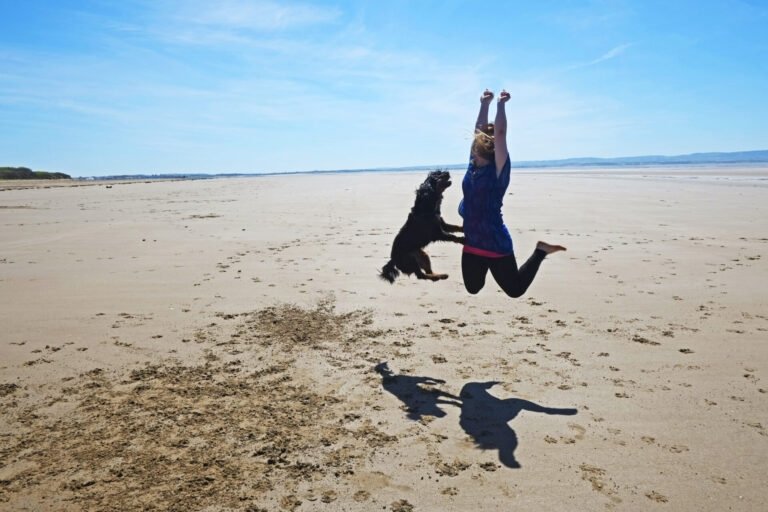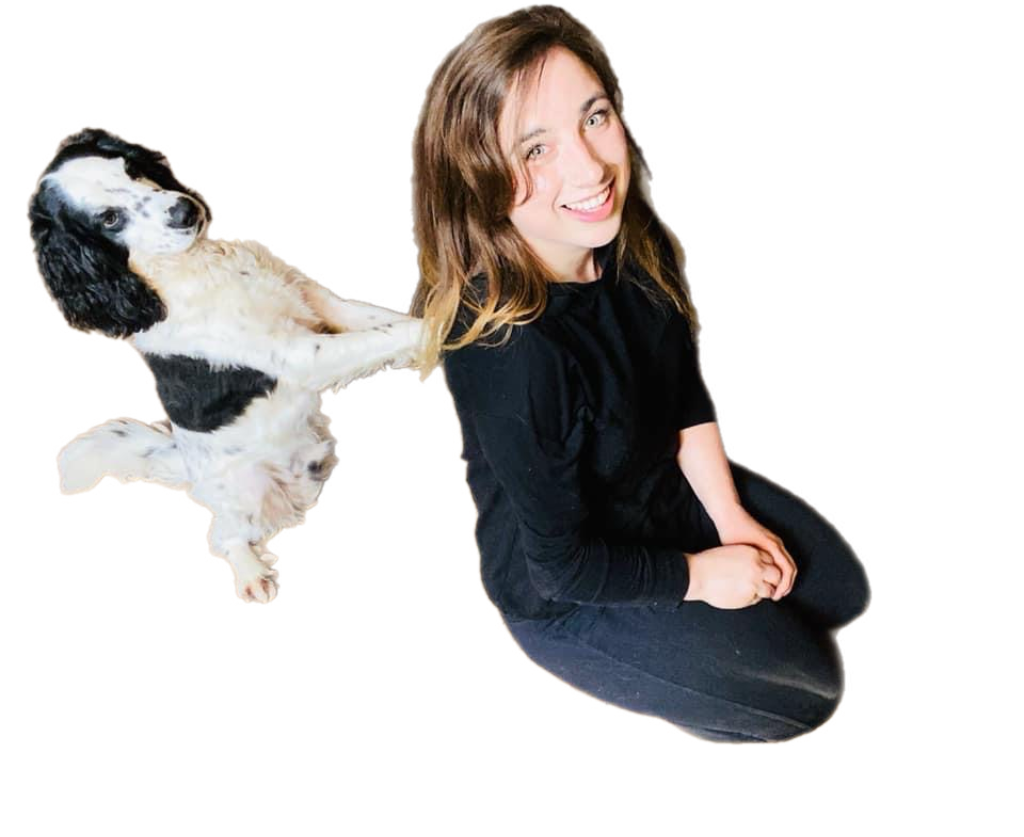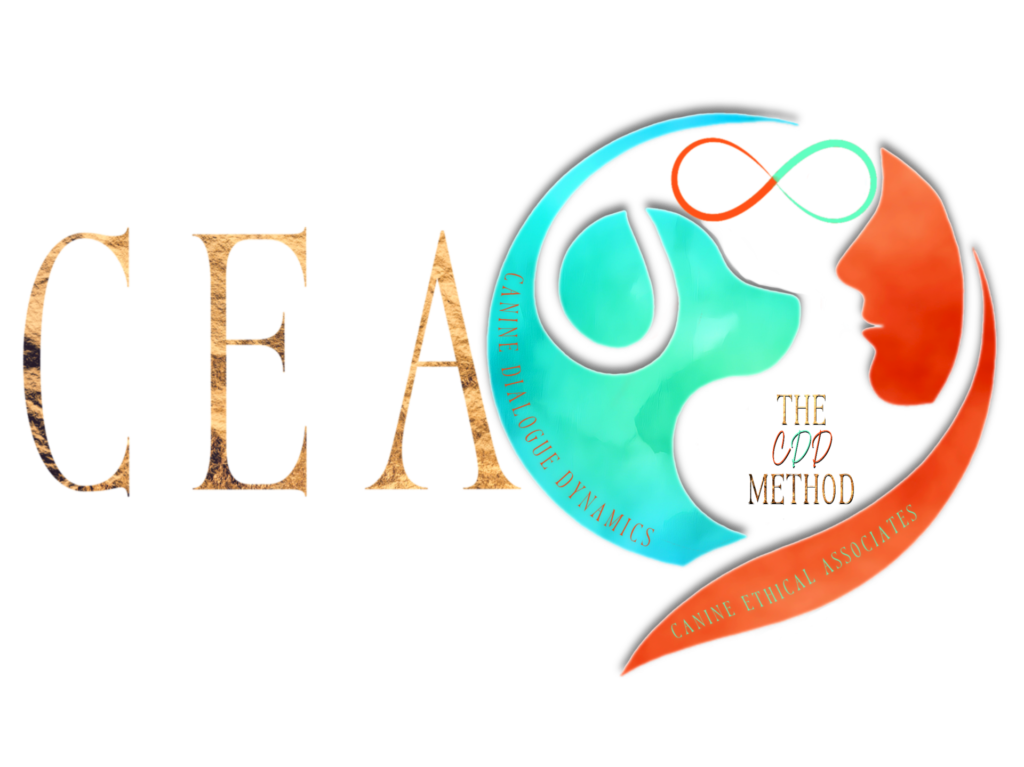The Canine Dialogue Dynamics (CDD) Method is a complete shift in how we live, teach, and connect with dogs. Rooted in trust, communication, and emotional understanding, it moves away from command-based training and towards something far deeper: conversation.
The CDD Method is not about obedience. It’s not about control, compliance, or reward-based conditioning. It’s about building a relationship with your dog that’s rooted in mutual respect, trust, and meaningful connection.
This method is based on the belief that dogs are not robots to be programmed or controlled. They are intelligent, emotional, thinking beings who learn best through real dialogue, not domination.

No Commands. No Conditioning. No Treat Bribes. Instead, we use natural language, tone, rhythm, body cues, and daily interaction to build understanding over time.
We Focus on Emotional Intelligence. Using principles from affective neuroscience, the CDD Method helps dogs become emotionally resilient, thoughtful, and balanced.
We Teach Through Dialogue, Not Control. Teaching becomes a shared experience. Dogs learn to make decisions, understand their environment, and respond with awareness.
We Respect Individuality. Every dog is different. Their breed, personality, and life experience matter. We tailor the way we teach to the dog in front of us.
We Build Trust, Not Dependence. CDD dogs aren’t reliant on cues or rewards to behave. They learn to think, adapt, and make safe, thoughtful choices because they understand their world.
The CDD Method is for people who want to:
See their dog as a family member, not a project.
Live in harmony, not under pressure.
Let go of power struggles and constant correction.
Learn to understand and communicate with their dog on a deeper level.
Raise a dog who is emotionally balanced, intelligent, and capable.
Embrace a natural, holistic, and respectful way of living together.
This method is especially powerful for:
Puppies and adolescent dogs
Dogs who struggle with reactivity or emotional overwhelm
Rescue dogs learning to trust again
Guardians who want to unlearn control and discover connection

The CDD Method begins with a shift in mindset. It’s about slowing down, observing your dog without judgement, and choosing to engage with them as a thinking, emotional being. It’s not a set of tasks or drills—it’s a living, evolving conversation.
Here’s what that looks like in daily life:
Word Association – You begin using words intentionally, naturally pairing them with daily actions and experiences. Words like “slowly,” “wait,” “this way,” and “shall we?” become part of your dog’s understanding, not because you train them, but because they hear them in context.
Narration – You talk to your dog as you go about your day. You explain what’s happening, what you’re doing, and what’s coming next. This helps your dog feel safe, included, and more aware of their surroundings.
Questions and Choices – Instead of commands, you ask questions and observe your dog’s response. You might say, “Do you want to come this way?” or “Shall we leave that?”—and you learn to trust the answer. It builds autonomy and connection.
Understanding Responses – You learn to read your dog’s body language, facial expressions, and emotions in real time. You don’t correct or control—you respond, adjust, and guide with empathy.
Contextual Learning – Your dog learns not through set sessions but through living. Walks, mealtimes, visitors, rest—all become part of a holistic learning journey. There’s no artificial setup. Just real life, lived together.
The method requires patience, awareness, and emotional presence. It’s deeply rewarding, but also deeply human. It brings you into partnership with your dog, where both of you are learning from each other, every day.
The CDD Method isn’t just about how we teach dogs. It’s about how we live alongside them. It’s about slowing down, noticing the small things, and choosing to engage with our dogs as intelligent, feeling beings.
If you’re ready to stop controlling and start connecting, you’re in the right place.
This isn’t training. This is a conversation. And your dog is ready to talk.

Raising a dog with the CDD Method is like teaching a child to ride a bike—gently, patiently, and with guidance that adjusts as they grow. It’s not about strict rules or robotic training sessions. It’s about helping your dog become thoughtful, emotionally secure, and confident in the world they live in.
We begin by creating an environment that is both safe and free. Boundaries exist—but only to protect, not to control. There are no unnecessary restrictions, no harsh corrections, no pressure to “perform.” Instead, we give your dog space to explore, paired with gentle, clear guidance that helps them understand the world at their own pace.
Safe, Flexible Boundaries:
We create gentle limits for safety, not for obedience. We allow exploration while quietly guiding when needed—using tone, body language, and calm redirection. Think of it as stabilisers on a bike: there when necessary, removed when your dog shows readiness.
Emotional Awareness:
We honour the emotional life of a dog. Dogs feel excitement, fear, frustration, and joy—all of which influence how they behave. The CDD Method recognises these feelings and teaches in ways that soothe, support, and build resilience.
Developmentally Appropriate Teaching:
We don’t rush or overwhelm. The brain of an 8-week-old puppy is not the same as a 6-month-old adolescent. We adapt teaching to match their stage of development—helping them feel successful, not confused or pressured.
Language from the Start:
We begin speaking with intention from day one. Words are gently paired with experiences—“slowly,” “this way,” “all done,”—not taught as commands, but absorbed through living. This creates a strong foundation for understanding without ever needing to drill or cue.
Choices and Confidence:
We offer choices. Do you want to go this way or that way? Would you like to meet this person? Are you ready to try that? This doesn’t make dogs confused—it makes them confident. They begin to think for themselves while still looking to you for guidance.
Freedom That Grows with Understanding:
As your dog matures and learns to communicate, we gradually offer more responsibility and space. We observe how they respond, and if they show readiness, we give a little more. The stabilisers come off naturally—not through pressure, but through trust.
Raising a puppy or a adult dog with the CDD Method means raising a dog who is thoughtful, emotionally stable, socially aware, and deeply bonded to their family. It’s not about controlling behaviour—it’s about nurturing development.

Reactivity isn’t a behaviour problem. It’s an emotional response.
Dogs who bark, lunge, freeze, or panic aren’t being “naughty”—they’re overwhelmed. They’re trying to make sense of a situation that feels too much, too fast, too intense. And when their behaviour is met with correction, restraint, or pressure, the underlying emotion doesn’t go away—it intensifies.
The CDD Method sees reactivity not as something to suppress, but something to listen to. Behind every reactive outburst is a story—a dog trying to communicate fear, frustration, uncertainty, or unmet needs.
Here’s how we help:
We don’t flood or desensitise. We don’t force dogs to “face their fears” or reward them into tolerance. Instead, we slow life down. We give space. We offer safety. We observe and adjust. Only when the dog feels safe can learning truly begin.
Reactivity is often the result of poor anticipation. With the CDD Method, you learn to read your dog’s signals long before they reach their threshold. You guide with calm redirection, not control. You gently shift the emotional momentum before it spirals.
Instead of giving commands, we speak. “Shall we go this way?” “Let’s head to the quiet path.” “You’ve seen enough, let’s take a break.” This kind, conversational language creates a rhythm your dog can follow—and one they can trust.
Many reactive dogs live in a state of constant arousal. The CDD Method helps bring them into a calmer, more regulated emotional state by focusing on activities that feel safe, satisfying, and grounding. We build up the dog’s emotional reserves before asking them to stretch.
Reactivity isn’t something to control—it’s something to understand. We ask why. We explore the emotional, neurological, physiological, and environmental roots. We support the dog as a whole being—not just manage the symptoms.
With this method, dogs don’t have to shut down, be bribed, or corrected into “good behaviour.” They learn to trust their person, their surroundings, and most importantly—themselves.
And that’s where the change happens.

The CDD Method isn’t just kind—it’s evidence-based.
At its core, the method draws from modern psychological understanding, neuroscience, and current research in canine cognition and emotional development. It’s not anecdotal. It’s not based on tradition or trends. It’s built on what science now tells us about how dogs learn, feel, and relate to the world around them.
Inspired by the work of neuroscientist Jaak Panksepp, the CDD Method recognises that dogs, like humans, have primary emotional systems in the brain—such as SEEKING, FEAR, CARE, and PLAY. These systems shape behaviour from the inside out.
When we understand which emotional system is activated, we can respond with the right kind of support—whether it’s calming a fearful dog, enriching a bored one, or soothing a pup whose CARE system is overwhelmed by separation.
This approach shifts the focus from what the dog is doing to why they’re doing it.
The method also aligns with developmental psychology. Puppies and adolescent dogs are going through rapid brain changes—similar to human children and teens. The CDD Method doesn’t expect more than a dog can give. It adapts to their stage of cognitive and emotional development, providing support that’s realistic and respectful.
We don’t rush learning. We build trust, stability, and internal regulation—skills that allow a dog to thrive, not just behave.
Studies show that dogs can understand hundreds of words, phrases, and emotional cues—especially when learned naturally through repetition and context. The CDD Method embraces this, allowing language to evolve as part of daily life rather than through rigid drills.
Dogs learn the way young children learn language—by being immersed in meaningful, emotionally safe conversation.
While the method respects behavioural science, it also moves beyond the Four Quadrants of operant conditioning. Real life doesn’t fit neatly into boxes—and neither do dogs. Emotions overlap, behaviours are layered, and learning is ongoing. The CDD Method responds to that complexity with nuance, flexibility, and understanding.
This is not a feel-good alternative to “real training.”
This is real teaching—backed by research, guided by empathy, and aligned with how dogs actually learn.

Whether you want to raise your puppy through the CDD Method, help your dog overcome reactivity, support your adolescent dog through big emotional shifts, guide your newly adopted rescue, enrich your adult or senior dog’s life, help your dog through fear or anxiety, or even become a professional CDD Practitioner—we have options for you.
Explore:
Our online courses for learners around the world
In-person programmes in Surrey and Hampshire
Ongoing mentorship for professionals
And dive deeper into the philosophy behind this method with Bethany Bell’s books:
Redefining Reactivity
Barking Up a New Tree: Rethinking Dog Training
A Dog With No Name
If you’re ready to step into something different—something kinder, wiser, and more meaningful—you’re in the right place.
Let’s raise dogs with dignity. Let’s teach through connection. Let’s begin the conversation.
The CDD method is a force-free, ethical approach to dog behaviour and training. It prioritises understanding, communication, and empathy, focusing on a dog’s emotional well-being rather than just outward behaviour.
Because we know that dog’s brains are more advanced and capable of learning much more than what is currently believed. We know that dogs understand far more receptive language than a 2–3-year-old child. With this in mind, we know that dogs flourish expediently when we switch instructional basic language to educational language. We wouldn’t teach a child over 4-6 years old in the same way we teach a toddler, so it does not make sense to remain at this basic level when teaching dogs. This is not beneficial to them.
Training is just one polarised way of teaching dogs. It involves using repetition and conditioning alongside desensitisation. This doesn’t benefit every single dog, and although it does have its place in the dog world, we offer an alternative way of teaching dogs. Dogs are perfectly capable of learning and developing through educational teaching in a more natural way. Whilst retaining the ethos of force-free methods, and just minimising the training element, we teach dogs how to live their life to the fullest whilst remaining safe and self-controlled. Lead walking, recall, social skills, confidence building, and polite and appropriate behaviour are still taught with CDD, but we do remove unnecessary strict rules.
Dog training isn’t the same as how we teach, and although the word ‘training’ does overlap when we refer to how we teach children and people that isn’t the same training that we apply to dogs. When we apply training to people, we are training them for a specific skill. This is done by repeating the same technique over and over until it is perfected, but we aren’t using that same approach to teach them how to do everything in their life. When people are training for something, they don’t have someone luring them with treats or someone punishing them if they get it wrong. They are simply learning through experience and repetition. So, dog training and people training for specific skills are entirely different.
Traditional training often emphasises on commands and obedience, sometimes using treats or corrections. CDD, on the other hand, dives deeper into understanding the root causes of behaviours, using communication and emotional understanding to guide a dog towards healthier behaviour choices.
No, the CDD method is entirely force-free and does not rely on punitive measures. It’s based on scientific evidence and established psychological principles, promoting positive reinforcement and understanding.
Yes, the CDD method is adaptable and can be tailored to fit the unique needs of any dog, regardless of age, breed, or size.
While you can integrate other force-free techniques, it’s crucial to ensure they align with the principles of CDD for consistency and effectiveness.
Yes, here are my past and current qualifications.
Workshops and Certificates
I proudly began my journey as a dog trainer’s assistant for a highly reputable training company in Surrey in 2010, and from there, I went on to thrive in the industry. In 2013, I took my skills to another training company where I continued to achieve great success until 2015. My passion and dedication led me to start my own dog training company, “Barking Up the Right Tree,” in 2017, and I’m happy to say that it has been a success through 2022. Additionally, I was honored to be an approved assistant dog trainer for “Veterans With Dogs and Dog Aid.” My years of experience and hard work have given me the confidence to continue making a lasting impact in the world of dog training.
I have had the pleasure of sharing my life with a number of wonderful dogs over the years. My first dog, Raffy, was a Golden Retriever who came into my life when I was just 10 years old. He brought me countless years of joy and companionship. Later, I was fortunate enough to share my home with Smash, an English Bulldog who also left a lasting impression on my heart. Sadly, both Raffy and Smash have passed away, but their memories will always be cherished. When I moved in with my in-laws, I had the pleasure of getting to know their three Welsh Terriers, Ted, Betty, and Trevor. They were a lively bunch and brought so much fun and energy to our household. Sadly, we’ve said goodbye to Ted, Betty, and Trevor in recent years, but their memories will never fade. My husband and I rescued two wonderful spaniels, Steve and Dave, who have taught us so much about behaviour and enriched our lives in countless ways. We’ve also had the opportunity to foster Sam, a Romanian rescue, and Joyce, a Golden Retriever, both of whom are now living happily in their forever homes.
After observing the challenges faced by many dog owners and the limitations of training methods, I was inspired to create a method that prioritised understanding, empathy, and communication.
Discover The CDD Method. We’re Here To Guide You Every Step Of The Way.


Discover The CDD Method. We’re Here To Guide You Every Step Of The Way.

Canine Ethical Associates © All Rights Reserved 2025